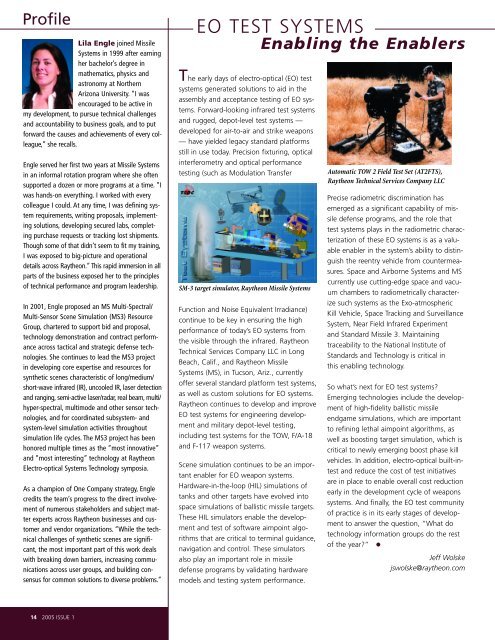RAYTHEON BRINGS EO TECHNOLOGY To Defend Our Nation
RAYTHEON BRINGS EO TECHNOLOGY To Defend Our Nation
RAYTHEON BRINGS EO TECHNOLOGY To Defend Our Nation
You also want an ePaper? Increase the reach of your titles
YUMPU automatically turns print PDFs into web optimized ePapers that Google loves.
Profile<br />
Lila Engle joined Missile<br />
Systems in 1999 after earning<br />
her bachelor’s degree in<br />
mathematics, physics and<br />
astronomy at Northern<br />
Arizona University. “I was<br />
encouraged to be active in<br />
my development, to pursue technical challenges<br />
and accountability to business goals, and to put<br />
forward the causes and achievements of every colleague,”<br />
she recalls.<br />
Engle served her first two years at Missile Systems<br />
in an informal rotation program where she often<br />
supported a dozen or more programs at a time. “I<br />
was hands-on everything. I worked with every<br />
colleague I could. At any time, I was defining system<br />
requirements, writing proposals, implementing<br />
solutions, developing secured labs, completing<br />
purchase requests or tracking lost shipments.<br />
Though some of that didn’t seem to fit my training,<br />
I was exposed to big-picture and operational<br />
details across Raytheon.” This rapid immersion in all<br />
parts of the business exposed her to the principles<br />
of technical performance and program leadership.<br />
In 2001, Engle proposed an MS Multi-Spectral/<br />
Multi-Sensor Scene Simulation (MS3) Resource<br />
Group, chartered to support bid and proposal,<br />
technology demonstration and contract performance<br />
across tactical and strategic defense technologies.<br />
She continues to lead the MS3 project<br />
in developing core expertise and resources for<br />
synthetic scenes characteristic of long/medium/<br />
short-wave infrared (IR), uncooled IR, laser detection<br />
and ranging, semi-active laser/radar, real beam, multi/<br />
hyper-spectral, multimode and other sensor technologies,<br />
and for coordinated subsystem- and<br />
system-level simulation activities throughout<br />
simulation life cycles. The MS3 project has been<br />
honored multiple times as the “most innovative”<br />
and “most interesting” technology at Raytheon<br />
Electro-optical Systems Technology symposia.<br />
As a champion of One Company strategy, Engle<br />
credits the team’s progress to the direct involvement<br />
of numerous stakeholders and subject matter<br />
experts across Raytheon businesses and customer<br />
and vendor organizations. “While the technical<br />
challenges of synthetic scenes are significant,<br />
the most important part of this work deals<br />
with breaking down barriers, increasing communications<br />
across user groups, and building consensus<br />
for common solutions to diverse problems.”<br />
14 2005 ISSUE 1<br />
<strong>EO</strong> TEST SYSTEMS<br />
Enabling the Enablers<br />
The early days of electro-optical (<strong>EO</strong>) test<br />
systems generated solutions to aid in the<br />
assembly and acceptance testing of <strong>EO</strong> systems.<br />
Forward-looking infrared test systems<br />
and rugged, depot-level test systems —<br />
developed for air-to-air and strike weapons<br />
— have yielded legacy standard platforms<br />
still in use today. Precision fixturing, optical<br />
interferometry and optical performance<br />
testing (such as Modulation Transfer<br />
SM-3 target simulator, Raytheon Missile Systems<br />
Function and Noise Equivalent Irradiance)<br />
continue to be key in ensuring the high<br />
performance of today’s <strong>EO</strong> systems from<br />
the visible through the infrared. Raytheon<br />
Technical Services Company LLC in Long<br />
Beach, Calif., and Raytheon Missile<br />
Systems (MS), in Tucson, Ariz., currently<br />
offer several standard platform test systems,<br />
as well as custom solutions for <strong>EO</strong> systems.<br />
Raytheon continues to develop and improve<br />
<strong>EO</strong> test systems for engineering development<br />
and military depot-level testing,<br />
including test systems for the TOW, F/A-18<br />
and F-117 weapon systems.<br />
Scene simulation continues to be an important<br />
enabler for <strong>EO</strong> weapon systems.<br />
Hardware-in-the-loop (HIL) simulations of<br />
tanks and other targets have evolved into<br />
space simulations of ballistic missile targets.<br />
These HIL simulators enable the development<br />
and test of software aimpoint algorithms<br />
that are critical to terminal guidance,<br />
navigation and control. These simulators<br />
also play an important role in missile<br />
defense programs by validating hardware<br />
models and testing system performance.<br />
Automatic TOW 2 Field Test Set (AT2FTS),<br />
Raytheon Technical Services Company LLC<br />
Precise radiometric discrimination has<br />
emerged as a significant capability of missile<br />
defense programs, and the role that<br />
test systems plays in the radiometric characterization<br />
of these <strong>EO</strong> systems is as a valuable<br />
enabler in the system’s ability to distinguish<br />
the reentry vehicle from countermeasures.<br />
Space and Airborne Systems and MS<br />
currently use cutting-edge space and vacuum<br />
chambers to radiometrically characterize<br />
such systems as the Exo-atmospheric<br />
Kill Vehicle, Space Tracking and Surveillance<br />
System, Near Field Infrared Experiment<br />
and Standard Missile 3. Maintaining<br />
traceability to the <strong>Nation</strong>al Institute of<br />
Standards and Technology is critical in<br />
this enabling technology.<br />
So what’s next for <strong>EO</strong> test systems?<br />
Emerging technologies include the development<br />
of high-fidelity ballistic missile<br />
endgame simulations, which are important<br />
to refining lethal aimpoint algorithms, as<br />
well as boosting target simulation, which is<br />
critical to newly emerging boost phase kill<br />
vehicles. In addition, electro-optical built-intest<br />
and reduce the cost of test initiatives<br />
are in place to enable overall cost reduction<br />
early in the development cycle of weapons<br />
systems. And finally, the <strong>EO</strong> test community<br />
of practice is in its early stages of development<br />
to answer the question, “What do<br />
technology information groups do the rest<br />
of the year?” •<br />
Jeff Wolske<br />
jswolske@raytheon.com

















